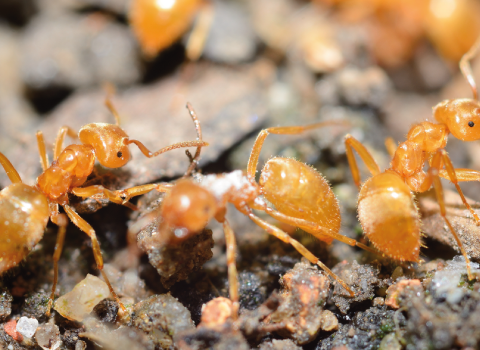Pharaoh’s Ant
The nests of Pharaoh’s Ants can often be found in small crevices located deep within the foundations or wall cavities of buildings, making it difficult to get to. Pharaoh ants are known to feed on almost anything, but are particularly attracted to sweet foodstuffs.
The ant Monomorium pharaonis (Linnaeus) is commonly known as the Pharaoh ant. The name possibly arises from the mistaken idea that it was one of the plagues of ancient Egypt (Peacock et al. 1950). This common household ant is distributed worldwide and carries the dubious distinction of being the most difficult household ant to control.
While there are no diseases specifically associated with Pharaoh’s Ants, owing to their small size they are able to penetrate all but the most secure packaging making them a problematic pest. This often leads to contamination of foodstuffs with pathogens, creating a particularly significant risk in public buildings such as schools or hospitals.
Prevention of Pharaoh’s Ants can be achieved through diligent food hygiene, but once their nest is built they can be extremely difficult to eradicate and should therefore be done by a qualified pest control professional. Control can be achieved by using juvenile growth hormone analogues – chemicals that mimic the action of juvenile growth hormone, preventing the larvae from developing, and sterilising the queens and winged males.
Biology and Nesting Habits
The Pharaoh ant colony consists of queens, males, workers, and immature stages (eggs, larvae, pre-pupae, and pupae). Nesting occurs in inaccessible, warm (80 to 86°F), humid (80%) areas near sources of food and/or water, such as in wall voids. The size of the colony tends to be large but can vary from a few dozen to several thousand or even several hundred thousand individuals. Approximately 38 days are required for development of workers from egg to adult.
Mating takes place in the nest, and no swarms are known to occur. Males and queens usually take 42 days to develop from egg to adult. The males are the same size as the workers (2 mm), are black in color and have straight, not elbowed, antennae. Males are not often found in the colony. The queens are about 4 mm long and are slightly darker than the workers (Smith and Whitman 1992). Queens can produce 400 or more eggs in batches of 10 to 12 (Peacock et al. 1950). Queens can live four to 12 months, while males die within three to five weeks after mating (Smith and Whitman 1992).
Part of the success and persistence of this ant undoubtedly relates to the budding or splitting habits of the colonies. Numerous daughter colonies are produced when a queen and a few workers break off from the mother colony. Even in the absence of a queen, workers can develop a queen from the brood, which is transported from the mother colony. In large colonies there may be as many as several hundred reproductive females (Smith and Whitman 1992).




